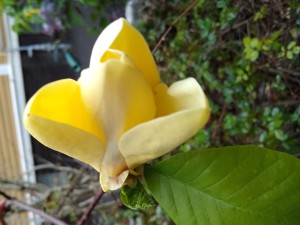I am very partial to yellow flowers—especially those that don’t normally bloom in that hue. I was one of the first gardeners of my acquaintance to buy ‘Barzella’, a yellow-flowered interspecies hybrid peony that represented a color breakthrough for peonies. A few years ago, I paid a premium for a newly-rediscovered heirloom yellow hyacinth. My garden is also home to several yellow roses and many bi-colors with yellow in the mix. At the moment, the roses are nowhere near bloom stage, but I don’t have to wait for my daily dose of yellow. All I have to do is turn my eyes towards the golden celandine poppies that are bursting forth every day under the rapidly leafing-out hydrangeas.
But even the biggest yellow rose or butter-colored peony in my garden is dwarfed by the largest of all—‘Elizabeth’, a yellow-flowered magnolia. ‘Elizabeth’ is young–under ten years old–but the tree already reaches the second story of my house. The tulip-shaped blooms are a rich butter yellow that ages to golden cream. Each is about four inches across when fully open and lightly fragrant. The tree is a magical site when it flowers every April.
According to an article in The Plantsman, a publication of the Royal Horticultural Society, ‘Elizabeth’ has about 60 yellow-flowered magnolia siblings. This yellowing of magnolias is a fairly recent phenomenon in the plant world. Hybridizing work began at the Brooklyn Botanic Garden in the 1950’s, when a team of female plant breeders crossed the American native Magnolia acuminata or “cucumber magnolia”, a tree with greenish-yellow blooms, and Magnolia liliaflora, a Chinese native magnolia with upright, pink, tulip-shaped flowers. After many crosses and back crosses, the team produced the first yellow-flowered magnolias. The work continued and the Brooklyn breeders brought other magnolia species into the genetic mix. The descenda nts of these plants are known collectively as the “Brooklynensis hybrids”.
nts of these plants are known collectively as the “Brooklynensis hybrids”.
Among the varieties of yellow magnolias are trees or multi-stemmed shrubs with tulip-shaped blooms in colors ranging from cream to primrose to golden yellow. Some are flushed with a bit of pink at the base of each bloom, perhaps harkening back to pink-flowered liliaflora ancestors. Yellow magnolias bloom any time from late March through mid-April, depending on variety and weather conditions. My magnolia, ‘Elizabeth’ is one of those Brooklyn hybrids. The variety is the result of crosses between Magnolia acuminata and Magnolia denudata, the “Yulan magnolia”, a Chinese native that bears fragrant white flowers. Introduced in 1977, ‘Elizabeth’ will grow into a 20- to 35-foot tree in time. The flowers are generally sterile, so ‘Elizabeth’ won’t present you with any unwanted seedlings. Like other magnolias, the variety has elongated, oval-shaped leaves that can grow up to nine inches long.
Though there are many lovely, “good growing” yellow varieties, ‘Elizabeth’ was recognized for vigor, beauty and reliability with the Royal Horticultural Society’s Award of Garden Merit. If you have the room for it, you can’t really go wrong with ‘Elizabeth’.
Though ‘Elizabeth’s flowers are generally sterile, breeders have been able to endow her with offspring. Among them is ‘Sunsation’, which is somewhat smaller, growing to about 16-feet tall in 10 years, with an upright habit. The flowers are yellow tinged with a bit of pink. Because of the variety’s smaller size and upright growth habit, it makes a good small garden or street tree.
If you relish yellow blooms, but want a slightly different look, try Magnolia ‘Golden Star’, a hybrid of a cucumber magnolia and a star or Magnolia stellata variety. Bred in Michigan by Phil Savage and introduced in the 1990’s, ‘Golden Star’ is slightly smaller than ‘Elizabeth’, topping out at about 21 feet. It combines soft yellow color with the star-like flower shape of its stellata parent.
I have always regretted that I could not grow a towering southern magnolia, or Magnolia grandiflora on my property. They don’t always do well in my part of the northeast, and even if they did, I really don’t have the space. Like just about everyone else, I am smitten with their huge white flowers and fabulous fragrance. Seeing ‘Elizabeth’ in full flower, back-lit by end-of-the -day spring light, makes me forget-at least temporarily–my southern magnolia envy.
Monrovia, the large wholesale and online retail nursery, features ‘Elizabeth’ among its inventory of flowering trees, but the website also mentions that it is currently out of stock. Your best bet for obtaining the plant this spring is to go to www.monrovia.com and locate a nearby Monrovia retailer. Call one of the listed retailers in your area and ask about ‘Elizabeth’ or any other yellow-flowered magnolias they have in stock. ‘Elizabeth’ or her yellow-flowered kin may be waiting for you on a nursery backlot.
